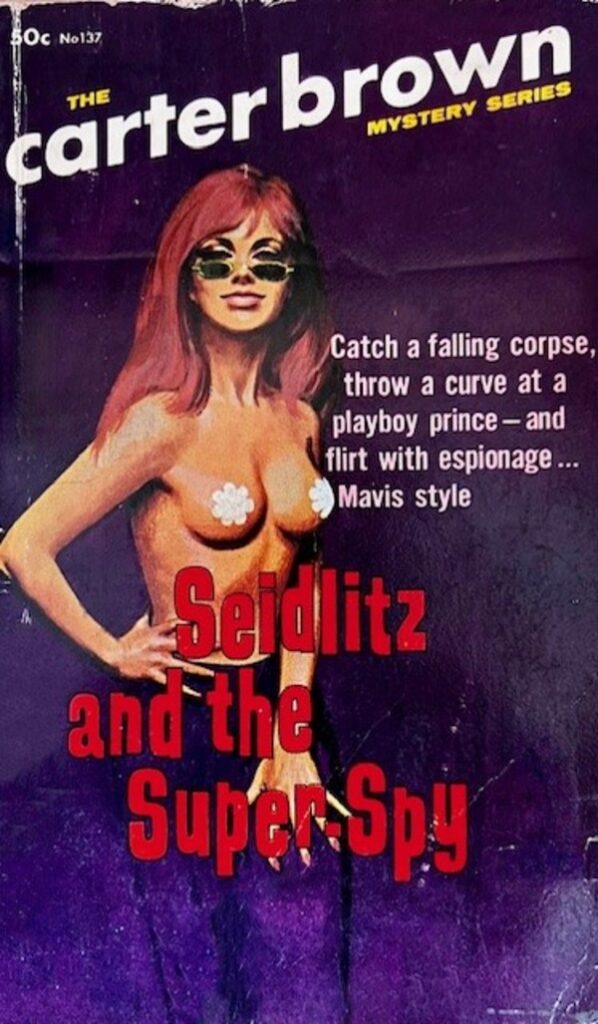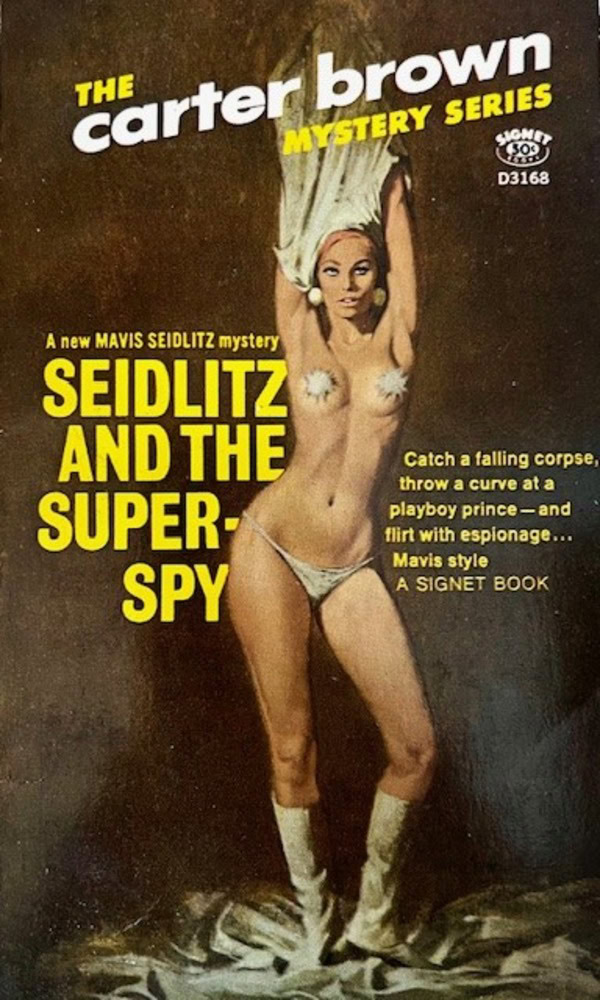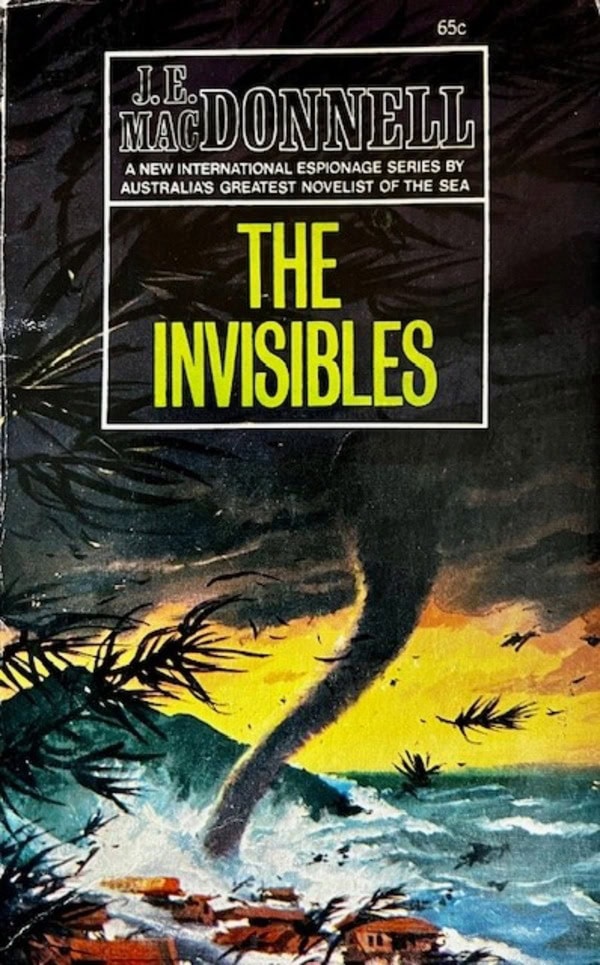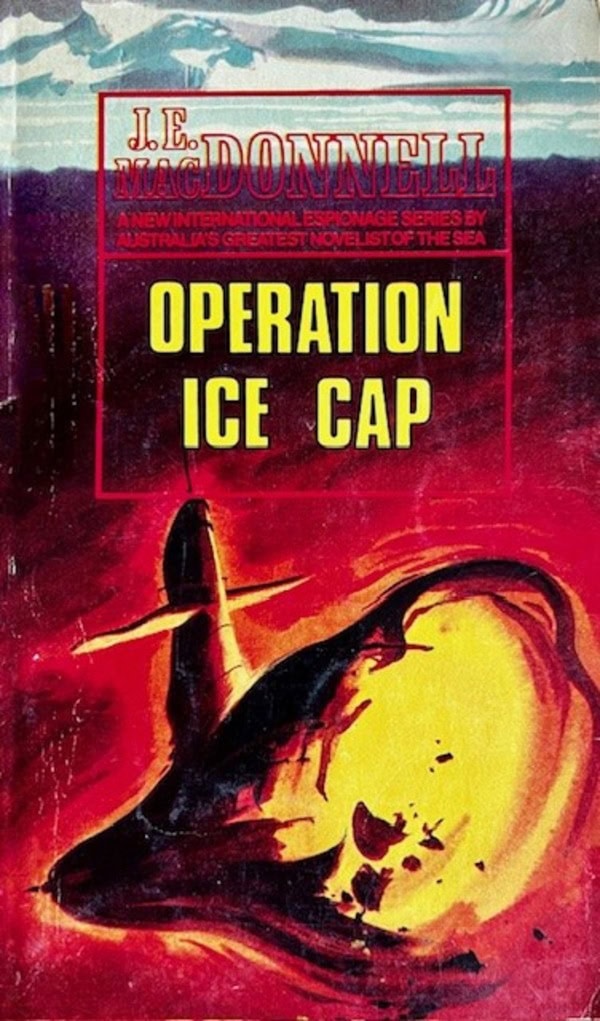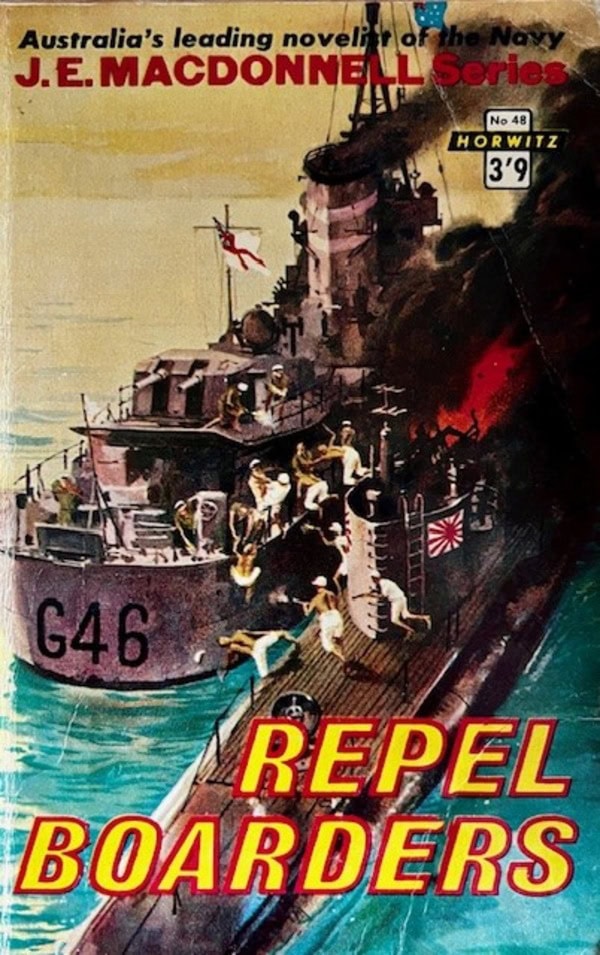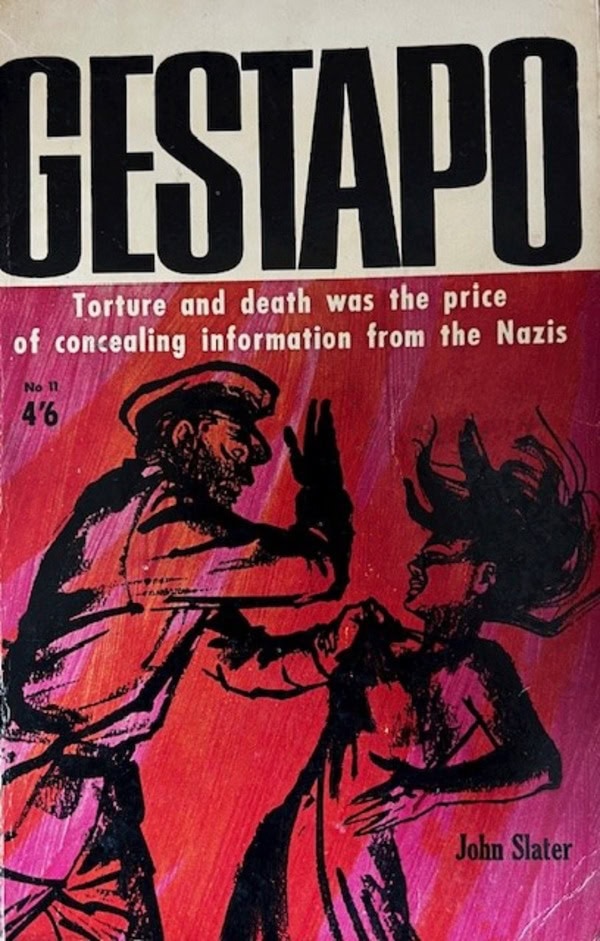TRASHY TUESDAY: HORWITZ BOOK HAUL and ANDREW NETTE’S BOOK ON HORWITZ PUBLICATIONS
During a recent book hunting trip through rural Victoria, I came across a nice selection of Horwitz paperbacks from the 1960s, including a couple of Carter Brown titles I did not have and two Mark Hood spy novels by J. E. Macdonnell.
I also recently got a copy of Andrew Nette’s definitive study of Horwitz: Horwitz Publications, Pulp Fiction And The Rise Of The Australian Paperback.
Horwitz were arguably the prime Australian publisher of paperbacks and pulp fiction in the 1950s and 60s. Probably best known in pulp circles for their publication of Carter Brown novels (as above), they also dabbled across the full spectrum of paperback fiction from westerns to detective fiction to war stories, medical romance, humour, racing car tales and a steady stream of unsavory books about pretty young white women being held captive and tortured by Nazis and Japanese soldiers during the war.
As Andrew Nette sets out in his book (below), Horwitz were a successful link between pulp and mainstream publishing and played a major role in the expansion of the paperback. They were very good at mining local and international publishing trends and fashions, and produced a steady stream of books that reflected and influenced Australian societal views and concerns.
The Carter Brown books by Alan G Yates were a mainstay of Horwitz’s publishing for several decades. Over 300 individual Carter Brown titles were released between 1951 and 1984, with most of them being reprinted on numerous occasions with different covers.
Lethal In Love (above) was originally published in 1953 by Horwitz and was reprinted in 1957 and again in 1960 as part of Horwitz’s Reprint By Demand series. The cover is typical early Horwitz Carter Brown, with a hand tinted photo of a scantily dressed lady provocatively looking at the prospective reader and set against a brightly coloured backdrop. The only thing lacking is the usual background images of silhouetted male figures holding guns and fighting.
This edition of Lethal In Love is probably one of the last digest sized Carter Brown books, before the move to conventional paperback sizing in 1960 and onwards. These digests are really hard to find these days in the wild, especially in decent condition, although I occasionally still stumble across some.
Update 18/6/2024: recently realised that the above photo on the cover of Lethal In Love is actually a photo of a very young Elke Somer taken from another source. As always with Horwitz, there is no acknowledgement of who the model is. Original photo below:
Seidlitz And The Super Spy (1967) is a later Carter Brown novel and is #137 in the The Carter Brown Mystery Series. It is the tenth book in his series about LA private eye Mavis Seidlitz, and seems to an attempt to cash in on the spy craze of the late 1960s.
The cover on this Australian first edition, has a nice groovy sixties feel to it, with the sunglasses and the strategically placed hippy flower images! It is different from the better known Robert McGinnis cover for the American edition of the book (below), which I am also lucky enough to have. The uncredited and more casual Australian cover is actually quite good and really catches the feel of the time.
There are numerous Carter Brown articles and cover photos on this site (just search Carter Brown), but here is a link to an article on some of the Australian covers: https://murdermayhemandlongdogs.com/trashy-tuesday-book-haul-carter-brown-horwitz-covers/
It would not be a Horwitz book haul without some J. E. Macdonnell titles.
Although best known as a naval war novelist, ‘Australia’s Greatest Novelist Of The Sea’ according to Horwitz, Macdonnell was looking for new literary fields by the early 1960s and turned to spy fiction in 1965.
Between 1965 and 1970 Macdonnell wrote 13 novels for Horwitz in his series about agent Mark Hood from the international intelligence agency Intertrust. The books were published in America under the nom de plume of James Dark, which is not to be confused with the James Dark novels produced by Horwitz in Australia. Despite what some sources say, in Australia all of the Mark Hood books appeared under Macdonnell’s name.
I recently wrote on the Mark Hood novels for Paperback Fanatic – https://murdermayhemandlongdogs.com/trashy-tuesday-paperback-fanatic-48-and-the-mark-hood-novels-by-j-e-macdonnell/), but was pleased to come across some covers I did not have during my recent book hunt.
The Invisibles (above) was the twelfth book in the series and was released in Australia in 1970. The story about Hood’s battle with a group of Caribbean Voodoo priests intent on using nuclear weapons to “make a human sacrifice of the entire world”, does not reach any great literary heights. It is also not well served by the Horwitz cover on the first edition (above), which seems more suited to a natural disaster thriller than spy novel promising “an orgy of lust, terror, and sudden death!”
The cover on Operation Ice Cap (Horwitz, 1970) is more suited to the book’s international espionage themes and more accurately reflects the key plot device about a weapon capable of melting nuclear submarines under the ice cap.
Nice first edition copies of Macdonnell’s war novels are still relatively easy to find, and this one about a battle between an Australian destroyer and a Japanese submarine features a particularly good cover with plenty of colour and action.
The John Slater series of exploitation novels (primarily written by the prolific Ray Slattery) was not a high point for Horwitz. The series ran from 1962 to 1973, and mainly featured stories about prisoners (usually women) being tortured by sadistic Nazi or Japanese guards during the war, or other forms of slavery and exploitation, such as Slave of the Apaches and Bikie Slave. The early books were initially about the Japanese POW camps and featured racially explicit taglines such as: “Inside a notorious prison camp where white women were made the unwilling playthings of their Japanese captors”. They very quickly, however, also moved into the Nazi realm.
Accompanying the descriptions were provocative covers that usually featured near-naked women, being tied up or beaten, or about to be subjected to some horrible act. The majority of the covers from 1964 onwards were done by famed illustrator Col Cameron, who did over a hundred covers for Australian paperbacks, mainly for Horwitz. This 1964 cover for Gestapo (probably not by Cameron), is very restrained by Horwitz standards. The black art class drawing set against a vivid coloured backdrop, is not explicit, but very effective in terms of portraying violence against women. It is actually more haunting than some of the exploitive covers that Cameron did, and it would not be allowed on book covers nowadays.
There are several articles on the John Slater exploitation novels on this site, especially the Japanese POW ones, but here is a link to another of the Nazi books: https://murdermayhemandlongdogs.com/trashy-tuesday-australian-nazi-exploitation-pulp-swastika-castle-by-john-slater-horwitz-1966/
In addition to publishing local books, Horwitz also reprinted books from overseas. In one of the strangest collaborations, Horwitz formed a joint venture with Penguin which took place over the period 1961 to 1963 and involved the publication of 33 books. These books were more literary than the usual Horwitz publication, but most were given the Horwitz pulp cover treatment.
Probably one of the best, is this lovely evocative cover for Alberto Moravia’s Bitter Honeymoon (Horwitz, 1961), which is well removed from the publisher’s usual output. The artist is not acknowledged, but it is very good.
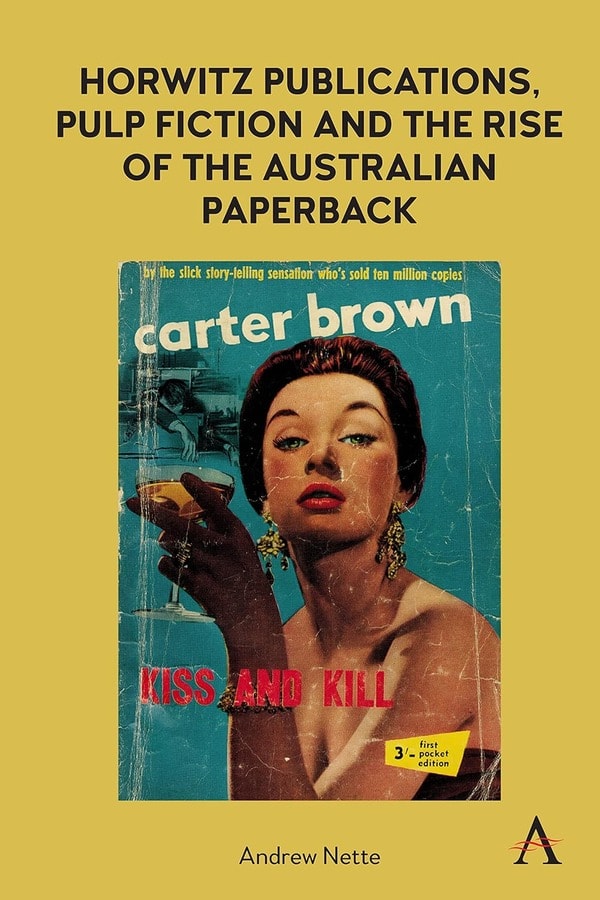
Andrew Nette’s Horwitz Publications, Pulp Fiction And The Rise Of The Australian Paperback (Anthem Press, 2024), is an overdue and absolutely fascinating book. Drawing on Andrew’s PhD, it tells the story of the rise of Horwitz publishing in the post World War II period and sets it against the general expansion of the paperback during the same period.
It is full of fascinating detail, a lot of which has not previously been published, and provides a broad canvas of how paperbacks were written, produced and distributed in Australia. Using interviews and other sources, Andrew describes the relationship between Horwitz and its authors, and the important role played by the various cover artists. Unfortunately, many of the artists and authors have now slipped away into obscurity, making it hard to evaluate individual contributions at times.
For me, some of the best parts of the book were Andrew’s clear articulation of his broader themes around Horwitz’s role as a conduit for societal modernisation and how the publisher adapted overseas trends for commercial purposes. It puts the rise of the publisher in a fascinating wider context and provides the intellectual rigour that is too often missing from discussions of paperback publishing. All of which is readily conveyed in a lucid and very readable manner, and illustrated with interesting interviews and personal reminiscences.
The book provides a very good base for further discussions around the detail, and highlights the need for further research on other Australian paperback publishers of the time, for instance Cleveland and Original Novels Foundation. A must read for anyone interested in popular culture and paperback publishing.





